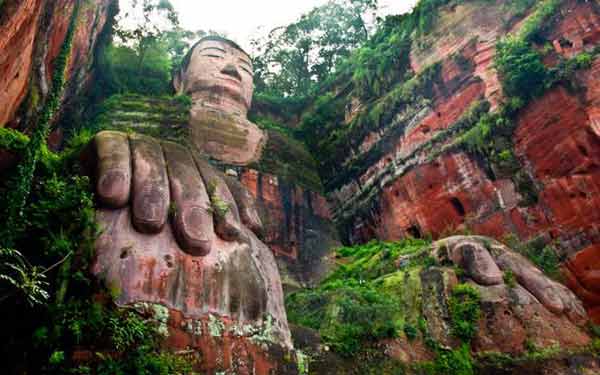
New Delhi, India (BBN)-The idea of travelling to a Buddhist destination brings about a feeling of calmness.
Most of us imagine a place where peace prevails, reports The India Today.
This is not only because we have always known Gautam Buddha as the symbol of peace.
Just close your eyes for a moment and imagine a monastery high up on the mountains -- you can picturise the Tabo monastery if you like -- the place is so serene that you want to leave everything behind and sit there for hours.
That's the feeling one gets in most Buddhist places.
Most Buddhist sites in the world are located in remote corners, hidden amidst beautiful natural surroundings.
These places can provide the perfect break from your mundane routine -- places where you can keep your gadgets aside and unwind in the lap of nature, and reclaim your faith on the existence of peace and harmony.
Here's a selection of a few remote places in the world with Buddha statues you might have never seen before.
LESHAN GIANT BUDDHA, CHINA

Photo: Wikimedia
Carved out of a cliff face of Mount Emi in the Sinchuan province of China, the Leshan Giant Buddha is the tallest Buddha statue in the world. Representing the Maitreya form of Buddha, the statue is 231 feet tall and is located at the confluence of Min River, Qingyi River, and Dadu River.
It is believed to be the tallest Buddha statue in the world.
The UNESCO World Heritage site was built way back in the ancient times of the Tang dynasty in China, when a Chinese monk named Haitong decided to calm the turbulent waters that troubled ships travelling down the river.
In order to show piety and sincerity to the cause, Haitong is said to have gouged out his own eyes when the project was threatened with lack of funding.
Although it couldn't be constructed in his lifetime, it was completed by his disciples 70 years later, when a governor of the Tang dynasty finally decided to sponsor the project.
The construction of this statue led to massive amounts of stone being carved out from the cliff face and thrown into the river.
The deposits at the riverbed was so high that the currents altered, making the place a safe passage for the rivers to pass.
REACH: The best way to reach this place is to take a bus from Chengdu (162 km) to Leshan City and from there change to a local city bus that will get you to this place.
AYUTTHAYA BUDDHA HEAD, THAILAND

Photo: Wikimedia
If you are planning to travel to Thailand anytime soon, make sure you include this place in your itinerary.
The ancient Buddhist site of Ayutthaya city in Thailand is home to a Buddha statue that you have never seen before.
All that this statue is the head of Buddha entwined within the roots of a tree.
As surprising as it sounds, the statue actually doesn't have a body to it.
Located among the ruins Wat Mahathat (The Temple of the Great Relic), the existence of this Buddha statue has been a mystery.
Although there are several theories, the most popular belief is that the Buddha head came into being when the Burmese army invaded the 14th century temple in 1767 and reduced it to ruins.
While the temple was destroyed, the army vandalised a lot of Buddha statues by chopping off their heads.
The area remained abandoned for many years until it was restored in the 1950s.
It is believed that it was during this period that a tree grew around one of the Buddha heads.
The statue-tree is located within the Ayutthaya Historical Park, where you can see many more ruins, restored beautifully by the Fine Arts Department, Ministry of Culture.
The park is also a part of the UNESCO World Heritage List.
REACH: The best way to reach this place is by trains available from Bangkok's Hualamphong Train Station.
The journey takes from an hour and a half to three hours, depending upon the train.
KOTHAUNG PAYA, MYANMAR

Photo: Wikimedia
This temple has the power to leave you speechless.
Well, it is but natural to be nothing but awestruck when you are a witness to 90,000 Buddha images at one place.
Yes, this temple actually houses so many of them!
Walking the moss-covered ancient site will make you wonder the way mankind has been capable of creations beyond imagination.
The Kothaung Paya temple is one of the key attractions in Mrauk U region of Myanmar.
This huge temple was built way back in 1553 by King Mintaikkha, son of King Minbin. Much of this site was excavated in several fragments spread across the area, and was reconstructed heavily in 1996.
The temple is believed to have been destroyed in the late 18th century by reasons unknown.
Legends suggest different reasons, including a major earthquake, a lightning, or a construction done with stones of inferior quality.
Whatever the past be, anybody who travels to this place would remember it forever.
REACH: The best way to reach this place is to hire a boat up the Kaladan River from the twon of Sittwe.
BBN/SK/AD